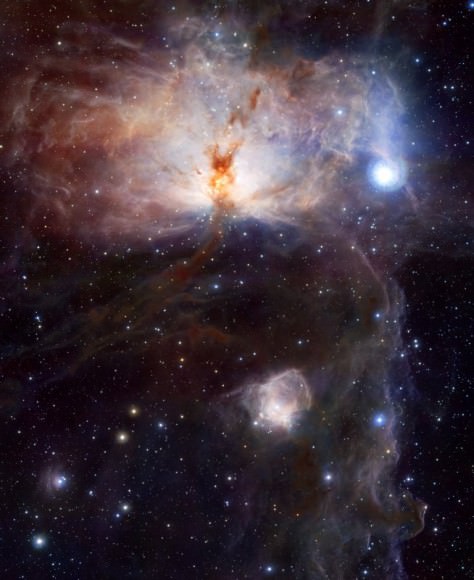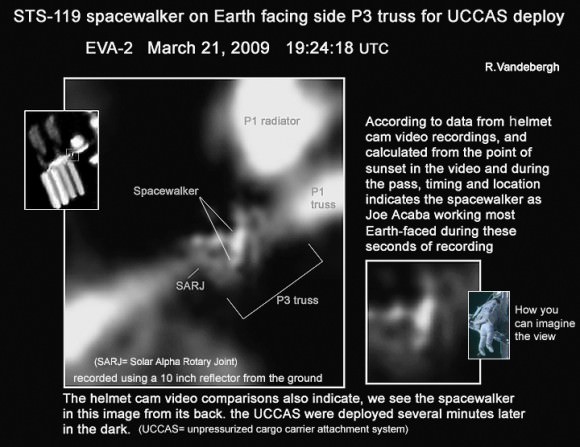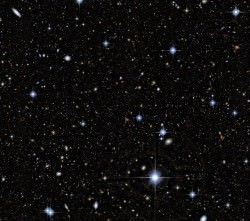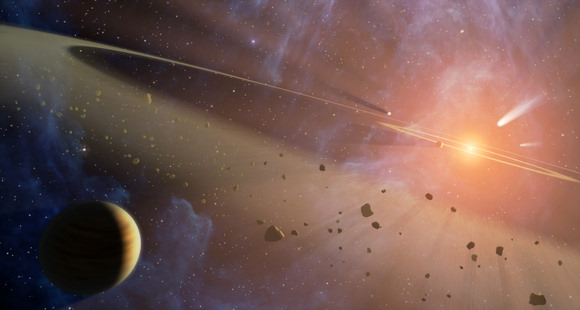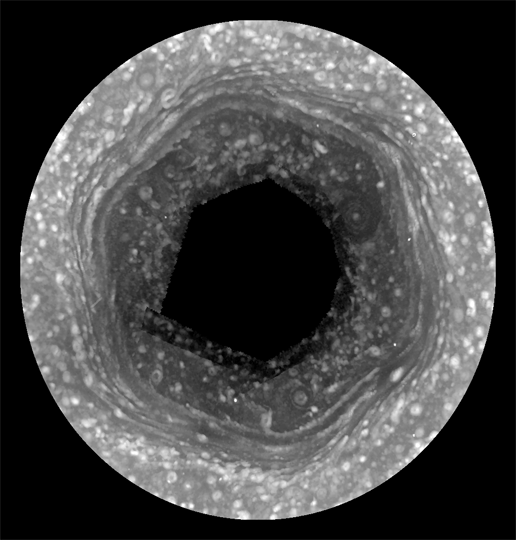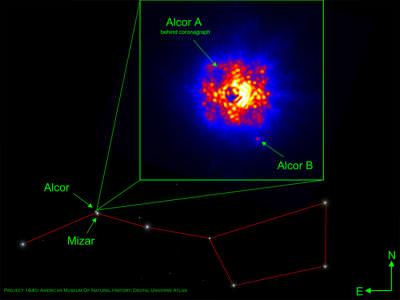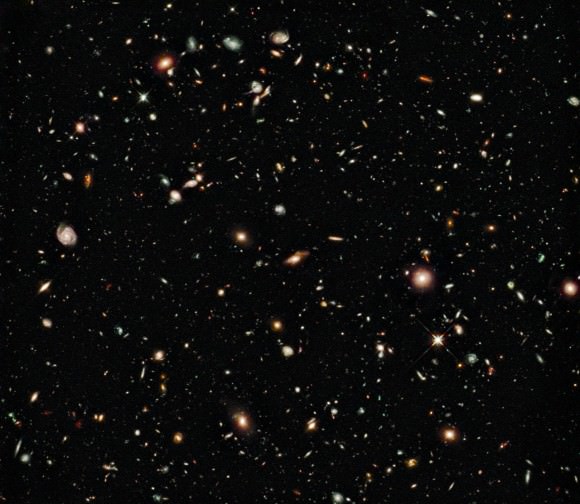Galaxy Zoo is Expanding to Include a Whole New "Zooniverse"
Galaxy Zoo has been an enormously successful citizen science project; so much so, that other astronomers, as well as scientists from other disciplines, have taken notice and now they want to get in on the act of having the public help make discoveries about our world and Universe. Today, the Galaxy Zoo team has launched Zooniverse. This new website will be a platform, or "home" to a plethora of new science projects where the public can take their pick of where and how they can make meaningful contributions and discoveries.
(...)
Read the rest of Galaxy Zoo is Expanding to Include a Whole New "Zooniverse" (683 words)
First (of many) Gorgeous Pictures from the New VISTA
Well, the WISE infrared all-sky satellite may be delayed until Monday, but the new infrared southern sky survey telescope VISTA (Visible and Infrared Survey Telescope for Astronomy) right here on Earth has gone online and released its first few gorgeous pictures.(...)
Read the rest of First (of many) Gorgeous Pictures from the New VISTA (443 words)
Forming Planets Around Binary Stars
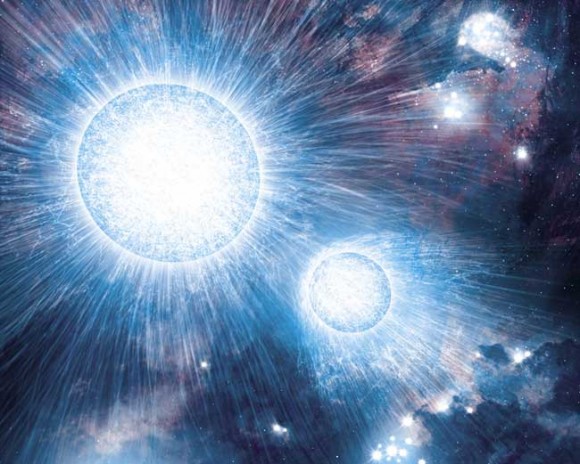
Fanciful science fiction and space art frequently depict the lovely visage of a twin sunset where a pair of binary stars dips below the horizon (think Star Wars). While it has been established that planets could exist in such a system by orbiting in resonances, that only holds true for fully formed planets. Can forming star systems even support an accretion disk from which to form planets? This is the question a new paper by M. G. Petr-Gotzens and S. Daemgen of the European Southern Observatory with S Correia from the Astronomiches Institut Potsdam attempts to answer.
(...)
Read the rest of Forming Planets Around Binary Stars (460 words)
Spirals, Tides, and M51
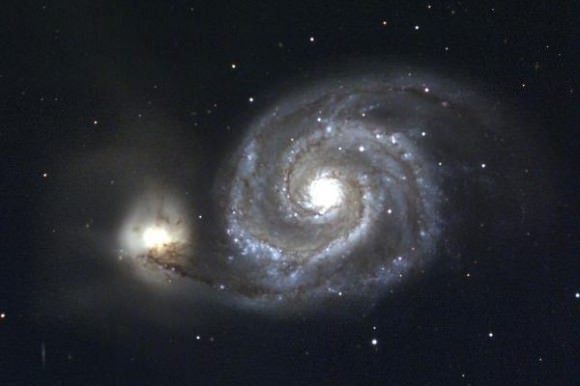
Spiral galaxies are undoubtedly one of the most beautiful structures in the universe. Yet, their simple elegance belies a complex nature. How do such structures not "wind up" and what causes them in the first place? The answers to these questions is a long standing challenge. Under one model, spiral structure is created by spiral density waves. In another, they are induced by tidal interactions. It is this approach that is explored in a new paper by Dobbs et al., accepted for publication in the Monthly Notices of the Royal Astronomical Society. Specifically, the authors attempted to use modeling of tidal forces to recreate the structure of the spiral arms on the grand design spiral, M51.(...)
Read the rest of Spirals, Tides, and M51 (732 words)
Phobos and Deimos Together At Last!
ESA's Mars Express orbiter took images last month of Mars two moons, Phobos and Deimos. This is the first time the moons have been imaged together in high resolution, but as Emily Lakdawalla points out on Planetary Blog, not the first time the two have been imaged together: the Spirit rover did it back in 2005! But these new image definitely provide a ‘wow’ factor, as well as helping to validate and refine existing orbit models of the two moons.
(...)
Read the rest of Phobos and Deimos Together At Last! (270 words)
Fermi Spies Energetic Blazar Flare
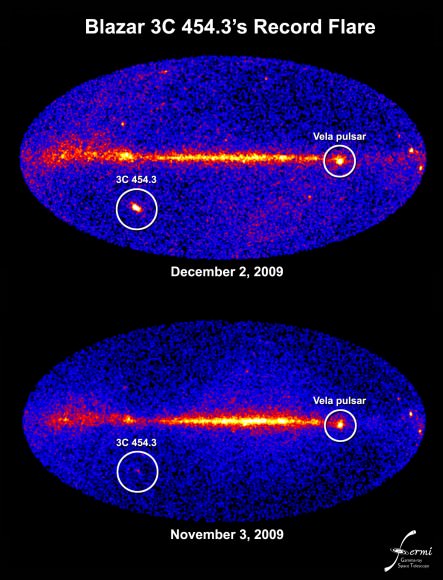
A comparison of the Fermi images from November 3rd and December 2nd of this year, showing the brightening of 3C 454.3. Image Credit: NASA/DOE/Fermi LAT Collaboration
The blazar 3C 454.3, a bright source of gamma rays from a galaxy 7 billion light-years away just got a whole lot brighter. Observations from the Fermi gamma-ray telescope confirm that since September 15th the blazar has flared up considerably, increasing in gamma-ray brightness by about ten times in the from earlier this past summer, making it currently the brightest gamma-ray source in the sky.
3C 454.3 is a blazar, a jet of energetic particles that is caused by the supermassive black hole at the center of a galaxy. Most galaxies are thought to house a supermassive black hole at their center, and as it chomps down matter from the accretion disk that surrounds it, the supermassive black hole can form large jets that stream out light and energy in fantastic proportions. In the case of 3C 454.3, one of these jets is aimed at the Earth, which allows for us to see and study it.(...)
Read the rest of Fermi Spies Energetic Blazar Flare (844 words)
NASA Science News for December 11, 2009
This week, researchers attending the United Nations Climate Change Conference in Copenhagen unveiled a unique web site that gathers and organizes climate data for decision makers, professional scientists and lay people.
FULL STORY at
http://science.nasa.gov/headlines/y2009/11dec_climateonestop.htm?list1035898
Wow! Astronauts on EVA, As Seen From Earth
Ralf Vandebergh's detail of an image he took on March 21, 2009 showing astronauts working outside the ISS. Credit: Ralf Vandebergh
Remember when it was a big deal when amateur astronomers starting imaging the International Space Station as seen from Earth, showing individual modules and other parts of the space station? One of the most proficient astrophotographers in that department has now just upped the game: Ralf Vandebergh has captured images of astronauts working outside the ISS during an EVA. Vandebergh, who lives in The Netherlands, used his 10-inch Newtonian backyard telescope to capture an image of STS-119 astronauts Joe Acaba and Steve Swanson working outside the ISS to install equipment on one of the trusses during the second EVA of the mission on March 21, 2009. Below, enjoy the video Vandebergh created about his extreme zoom-in handiwork.
Nice job Ralf! Check out his website of other telescopic spacecraft image here.
(...)
Read the rest of Wow! Astronauts on EVA, As Seen From Earth (0 words)
Half a Million Galaxies, Yours to Explore
Move over, Hubble Deep Field. The Canada-France-Hawaii Telescope has released a new deep-field image of as many as 500,000 galaxies out to a distance of 7 billion light years. And you can surf the entire image at high resolution with an interactive zoom feature at the CFHT website.
(...)
Read the rest of Half a Million Galaxies, Yours to Explore (246 words)
Earth's Atmosphere Came from Outer Space
A new study finds the gases which formed the Earth's atmosphere – as well as its oceans – did not come from inside the Earth but from comets and meteorites hitting Earth during the Late Heavy Bombardment period. A research team tested volcanic gases to uncover the new evidence. "We found a clear meteorite signature in volcanic gases," said Dr. Greg Holland the project's lead scientist. "From that we now know that the volcanic gases could not have contributed in any significant way to the Earth's atmosphere. Therefore the atmosphere and oceans must have come from somewhere else, possibly from a late bombardment of gas and water rich materials similar to comets."
(...)
Read the rest of Earth's Atmosphere Came from Outer Space (247 words)
Saturn's Hexagon Endures!
This movie from Cassini, made possible only as Saturn's north pole emerged from winter darkness, shows new details of a jet stream that follows a hexagon-shaped path and has long puzzled scientists.
The Cassini spacecraft was able to take another look at one of Saturn's strangest features – a bizarre six-sided cloud structure circling the entire north pole. This structure was hinted at when the Voyager spacecraft first visited the planet nearly 30 years ago, and Cassini was able to take a brief look a few years ago with Cassini's infrared camera. But these latest images provide evidence the hexagon-shaped jet stream is still there, (the north pole has been shrouded in darkness but has now recently emerged into sunlight) and gives scientists the most detail yet to study the intriguing hexagon shape crowning the planet.
(...)
Read the rest of Saturn's Hexagon Endures! (572 words)
Extra Star Found in the Big Dipper
The handle of the Big Dipper just got stronger! Astronomers have found an additional star located in the Dipper's gripper that is invisible to the unaided eye. Alcor, one of the stars that makes the bend in the Big Dipper's handle has a smaller red dwarf companion orbiting it. Now known as "Alcor B," the star was found with an innovative technique called "common parallactic motion," and was found by members of Project 1640, an international collaborative team that gives a nod to the insight of Galileo Gallilei.
(...)
Read the rest of Extra Star Found in the Big Dipper (601 words)
Very First Image of a Very Hot Star
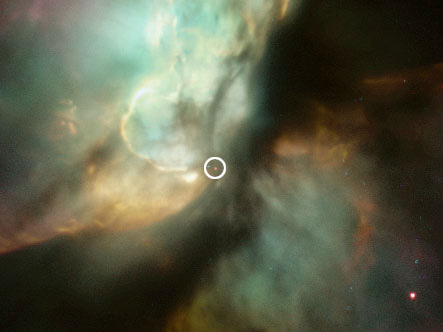
No, this article is not about Johnny Depp or Angelina Jolie. They may be hot stars, but in comparison to the star at the center of the Bug Nebula, pictured left, they've got nothin'. The first image of the star at the center of the Bug Nebula (NGC 6302) has been taken by a team of astronomers at the Jodrell Bank Centre for Astrophysics, using the newly refurbished Hubble Space Telescope. This star, one of the hottest in the galaxy, has a temperature of about 200,000 Kelvin – 33 times hotter than the Sun – and is at the center of one of the most beautiful planetary nebula in the galaxy.(...)
Read the rest of Very First Image of a Very Hot Star (627 words)
Hubble Takes a New "Deep Field" Image with Wide Field Camera 3
Hubble's latest image is another stunner — and just look at all the galaxies! Hubble has produced a new version of the Ultra Deep Field, this time in near-infrared light and taken with the newly installed Wide Field Camera 3. This is the deepest image yet of the Universe in near-infrared, and so the faintest and reddest objects in the image are likely the oldest galaxies ever identified, and they likely formed only 600–900 million years after the Big Bang. This image was taken in the same region as the visible Ultra Deep Field in 2004, but this new deep view at longer wavelengths provides insights into how galaxies grew in their formative years early in the Universe's history.
(...)
Read the rest of Hubble Takes a New "Deep Field" Image with Wide Field Camera 3 (500 words)
New Findings Say Mars Methane Comes from Life or Water — or Both
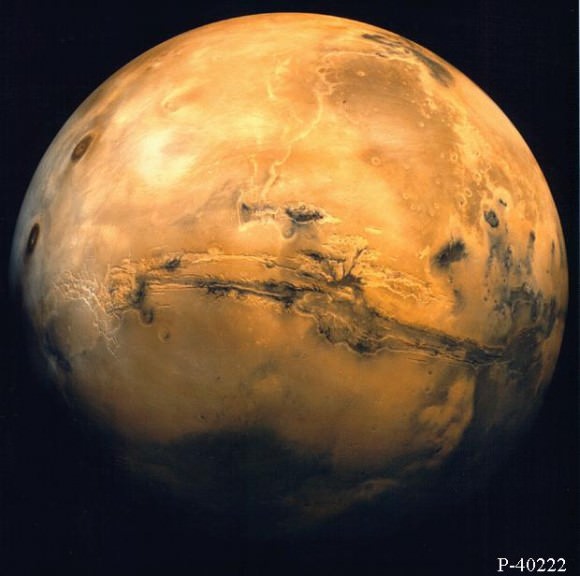
A new paper that will be published Wednesday rules out the possibility that methane is delivered to Mars by meteorites, boosting the idea that the short-lived gas perhaps could be generated by either life or water, or maybe even both. Microorganisms living in the Martian soil could be producing methane gas as a by-product of their metabolic processes, or methane might be created as a result of reactions between volcanic rock and water. Either way, the prospect is exciting.
(...)
Read the rest of New Findings Say Mars Methane Comes from Life or Water — or Both (542 words)

